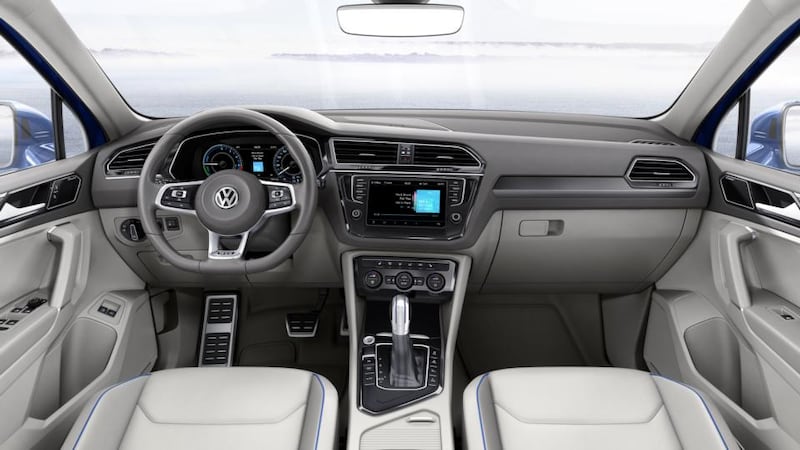The new Tiguan is the first salvo in Volkswagen's all-important assault on the global mid-size SUV market. Although the outgoing model has been successful, selling 2.64-million cars since it was launched, the new one comes at a critical time for VW. The all-important Chinese market is shifting more and more towards SUV sales, while in the US, VW and its dealers have blamed its consistent under-performance (it's out-sold stateside by comparative minnow Subaru) on an insufficient number of SUVs and crossovers in its range.
So the Tiguan is hugely important. It rides, entirely unsurprisingly, on the MQB chassis and components set which underpins almost every compact VW Group model. VW has developed four distinct sub-models for the Tiguan though – a basic 'vanilla' model, a more rugged off-road-style version, a very sporty and aggressive looking R-Line version and, still billed as a show car but definitely destined for production, a plugin hybrid GTE model, which boasts 42g/km Co2 emissions and 1,000km touring range on a full charge and a full tank of fuel.
VW claims that the new Tiguan is around 50kg lighter than before, model for model, but it has a much bigger boot – now breaking through the 500-litre barrier if you have the adjustable rear seat bench slid fully forward on its runners. The whole car is a full 60mm longer than before, with a 76mm increase in the wheelbase, which effectively bumps it up a class – whereas before it was a rival to the likes of the Nissan Qashqai, now it's closer to models like the Ford Kuga and Honda CR-V. A long-wheelbase version will also be introduced, primarily for the Chinese market but it may make it to the US and Europe as well, depending on demand. VW is remaining coy on the possibility of a seven-seat version for now though.

The styling doesn’t deviate much from the old Tiguan template – it’s still simple and relatively unadorned, but the front end takes much from the current Passat and looks a good deal more imposing, especially in R-Line trim with its extra bodykit and contrast black wheelarch lips.
Inside, VW is lifting Audi’s digital instrument technology to create a new 12.3-inch TFT instrument pack, which is said to be fully configurable by the driver and there’s a new heads-up display too as an option.
Volkswagen claims that even the base Trendline model has a number of advanced standard features. These include Front Assist that features City Emergency Braking and Pedestrian Monitoring as well as the active hood and the Lane Assist lane departure warning system. In addition, the safety equipment is completed by a network of seven airbags, including a knee airbag on the driver’s side, and the Automatic Post-Collision Braking System; it helps to avoid secondary collisions. Comfortline mid-level trims have the Driver Alert System as standard.
The top Highline trim is also equipped with adaptive cruise control (ACC), which utilizes radar to accelerate or brake the Tiguan and thus always maintain the correct distance to traffic ahead. If the Tiguan is equipped with DSG in addition to ACC, it automatically handles stop-and-go traffic as well (traffic jam assist). Other Tiguan driver assistance systems include the optional Side Assist (lane-changing assistant), Pre-Crash proactive occupant protection (detects elevated collision potential, tensions the front seatbelts to preventively restrain the driver and front passenger and closes open windows and the sunroof to just a small gap), Emergency Assist (recognises if the driver is no longer responsive and brakes the car to a stop) and Area View (360 degree all-round view using four cameras that is especially useful off-road).
There's also a choice of either 5-inch or 8-inch central touchscreen displays, which come with MirrorLink, Apple CarPlay and Android Auto for connecting to your mobile phone. Volkswagen is also launching its new Security & Service call-centre system on the Tiguan, which will be a rival to GM's OnStar and provides both online and voice connectivity to adjust the car's settings and call ahead to local points of interest.
The engine range is predictable – 1.6 and 2.0-litre diesels ranging from 120hp to a twin-turbo with 240hp. Four wheel drive is available on all models, and there are also 1.4 and 2.0-litre TSI turbo petrol engines with power outputs ranging from 125hp to 220hp, depending on the market. VW also claims that the car is more capable in off-road situations now, with an extra 10mm of ride height and better approach and departure angles for the off-roading version.












